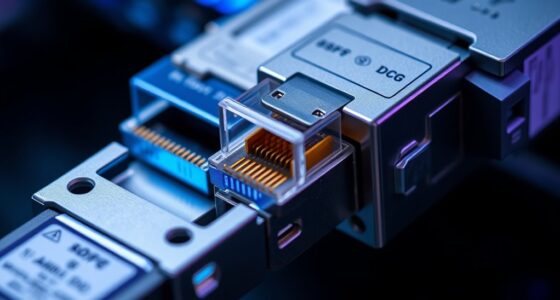In data centers, standard cable color codes help you quickly identify power, data, management, and fiber or copper connections for safety and efficiency. Power cables often use black or red, while network cables typically follow color schemes like blue for data and yellow or orange for special links. Consistent color standards reduce errors and improve troubleshooting. If you continue exploring, you’ll discover how to implement effective schemes tailored to your infrastructure needs.
Key Takeaways
- Power cables typically use black/red for live, white/gray for neutral, and green/bare copper for ground, following international electrical standards.
- Network cables often follow color codes like blue for data, yellow for management, and red for critical connections to facilitate quick identification.
- Standardized color schemes improve troubleshooting, maintenance efficiency, and safety by clearly distinguishing cable functions.
- Custom color coding strategies are used to tailor cable identification to specific equipment or operational needs.
- Consistency in color standards across data centers ensures compliance, reduces errors, and enhances overall cable management.
Common Color Coding Practices for Power Cables
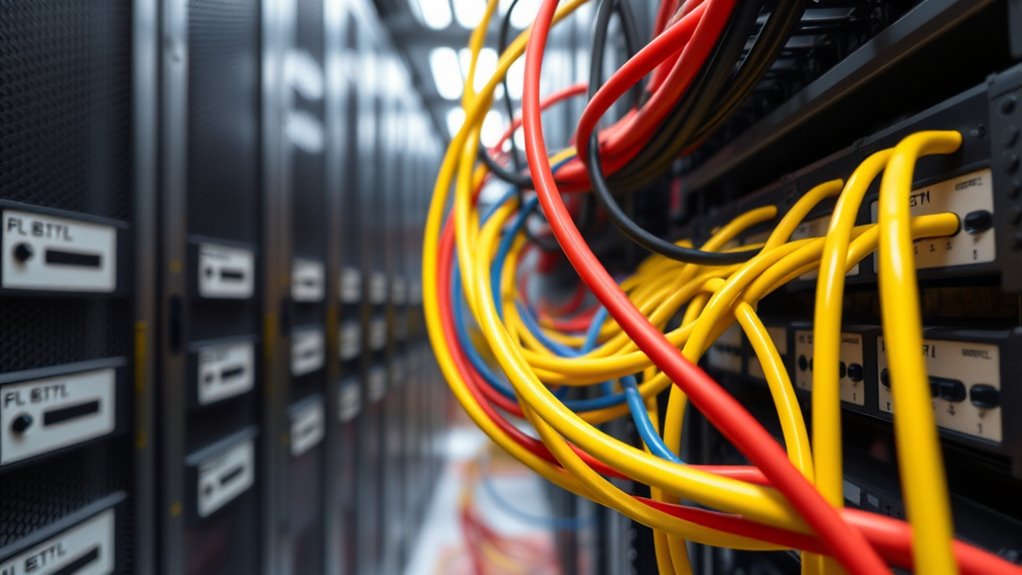
Understanding the common color coding practices for power cables is essential for guaranteeing safe and efficient electrical installations. Typically, cable insulation uses specific colors to identify the purpose of each wire, reducing the risk of errors. For example, black or red usually indicates live wires, while white or gray signifies neutral. Green or bare copper is reserved for grounding. When working with wireless cable setups, proper cable insulation remains vital to prevent interference and guarantee safety. Clear color coding helps you quickly identify connections, especially in complex data center environments. This standardization minimizes mistakes during installation or maintenance, guaranteeing that power flows correctly and safely. Additionally, cable color standards often align with international electrical codes, ensuring consistency across various systems and regions. Adhering to these practices enhances overall system reliability and safety for everyone involved. Proper training on cable identification can further improve safety and efficiency during electrical work. Implementing consistent color coding is also critical in preventing electrical hazards, thus protecting personnel and equipment from potential accidents.
Network Cable Color Coding Guidelines

Understanding network cable color coding helps you quickly identify cable types and functions. You should know the common color conventions, purpose-driven color codes, and how industry standards guide these practices. This knowledge guarantees your wiring remains organized, safe, and compliant with best practices. Familiarity with cable color standards ensures consistent and efficient data center management. Additionally, implementing aesthetic wall organization solutions can further enhance the clarity and accessibility of your cabling setup, especially when considering Kia Tuning modifications that require precise cable management.
Common Color Conventions
To guarantee consistency and ease of identification, many network cable installations follow standardized color conventions for their wires. These conventions simplify cable labeling, making it easier to trace and troubleshoot connections quickly. Commonly, blue indicates Ethernet data cables, while orange and green often signify crossover or patch cables. Red typically marks critical or emergency connections, and yellow is used for management or auxiliary links. Color psychology plays a role here, as bright colors like red and yellow draw attention to essential or high-priority cables. By adhering to these standards, you reduce confusion and improve overall network clarity. Standardized color coding helps ensure that anyone working in the data center can instantly recognize cable functions, streamlining maintenance and minimizing errors. Additionally, understanding sound healing science and proper skin protection can help prevent skin damage during outdoor activities, emphasizing the importance of consistent practices across different fields. Recognizing the importance of family connections and their influence can also aid in effective networking and resource sharing within organizations. Following these color standards enhances cable management efficiency and safety, making it easier for technicians to perform their tasks accurately.
Purpose-Driven Color Codes
Purpose-driven color codes are essential for ensuring that network cables serve specific functions and priorities. They help quickly identify cable roles, reducing errors and improving efficiency. Over time, the color code evolution reflects changing technologies and operational needs. Some organizations adopt vendor-specific schemes, which can vary from universal standards, adding complexity but catering to specific infrastructure requirements. To clarify, here’s a typical scheme:
| Function | Color |
|---|---|
| Data Transmission | Blue |
| Management & Control | Green |
| Power & Backup | Red |
| Testing & Spare | Yellow |
Understanding these schemes allows you to maintain clarity in your data center, ensuring each cable’s purpose aligns with your operational priorities and vendor protocols. Incorporating standardized color coding practices can further enhance the clarity and safety of your network infrastructure, especially as technologies evolve and new standards develop. Additionally, employing consistent labeling alongside color codes can improve maintenance and troubleshooting processes, supporting the overall child well-being by minimizing downtime and errors in critical systems.
Industry Standards Compliance
Industry standards for network cable color coding guarantee consistency and safety across various organizations and infrastructure setups. Adhering to these standards ensures proper equipment labeling, reduces errors, and streamlines maintenance. When you follow established guidelines, you can easily identify cable functions, such as data, power, or backup connections. Using color coding software helps automate and enforce these standards, minimizing human error. Keep in mind that compliance with industry standards also aids in troubleshooting and future upgrades. To deepen your understanding, consider these key points:
- Ensuring uniform color schemes across all network components
- Implementing software tools for accurate equipment labeling
- Staying updated with evolving industry regulations to ensure ongoing compliance
Following these practices helps you maintain a reliable, safe, and well-organized data center environment. Incorporating industry-standard color coding practices further enhances clarity and operational efficiency. Additionally, understanding regional variations in standards can be beneficial for multinational data centers. Emphasizing industry best practices can also support ongoing compliance and operational excellence.
Management and Console Cable Color Standards
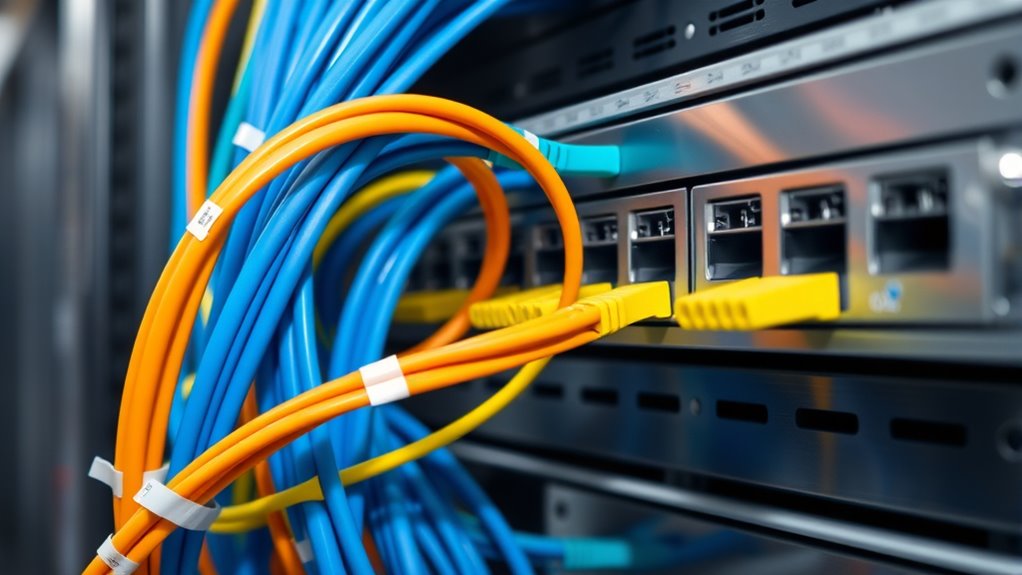
Using consistent colors for management and console cables helps you quickly identify their purpose. Standardized cable types guarantee compatibility and reduce confusion during setup or troubleshooting. Clear visual identification saves you time and minimizes errors in your network management. Moreover, adopting standardized color schemes can enhance overall security by preventing accidental connections to incorrect ports, which is vital in AI Security environments. Implementing risk management practices ensures that potential vulnerabilities are addressed proactively, safeguarding your data center infrastructure. Additionally, consistent color coding can facilitate industry compliance and streamline maintenance procedures. Proper documentation of cable color standards also supports training new staff and maintaining operational consistency across teams.
Color Coding Consistency
Have you ever wondered why consistent color coding matters for management and console cables? It ensures quick identification, reduces errors, and streamlines troubleshooting. When your organization enforces clear color coding policies, everyone knows which cables connect to critical systems. Maintaining consistency helps prevent accidental disconnections or misconfigurations. To achieve this, staff training is essential—teaching technicians to recognize and follow established standards. You should also document color schemes clearly and enforce their use across the team. Consistent color coding minimizes confusion during maintenance and accelerates problem resolution. Ultimately, following these practices improves overall data center efficiency and reliability. By prioritizing adherence to color coding policies and ongoing staff education, you create a safer, more organized environment for managing your infrastructure.
Standardized Cable Types
Standardized cable types play a essential role in maintaining clear and consistent management and console cable color standards. By establishing specific cable color symbolism, you simplify identifying different functions and connections, reducing errors and streamlining troubleshooting. For example, using distinct colors for management, console, or power cables helps you quickly locate and differentiate cables. Additionally, ergonomic cable design enhances usability by ensuring cables are easy to handle, install, and manage within tight spaces. These standards promote efficiency and safety, minimizing clutter and accidental disconnections. When you follow consistent cable types and color schemes, your data center becomes more organized, making maintenance and upgrades faster and more accurate. Ultimately, proper cable type standardization improves overall operational reliability and clarity.
Visual Identification Benefits
Wouldn’t it be easier to manage your network if you could instantly identify management and console cables at a glance? Proper cable color standards enhance your ability to distinguish cables quickly, reducing errors and saving time. By leveraging color perception and visual contrast, you can create a clear, intuitive system that simplifies troubleshooting and maintenance. For example, assigning specific colors for management, console, and data cables ensures immediate recognition. This visual differentiation minimizes confusion, especially in crowded racks or complex setups. Additionally, consistent color schemes promote better team communication and streamline training. When cables stand out through effective color contrast, you gain improved visibility and control, making network management more efficient and less error-prone.
Differentiating Fiber Optic and Copper Cables
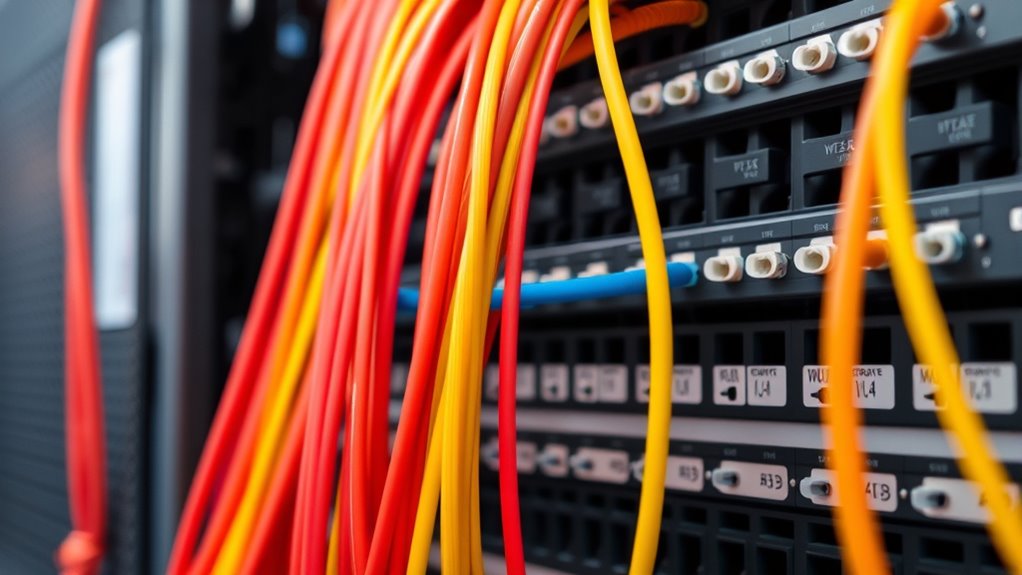
To effectively differentiate fiber optic cables from copper cables, it’s important to understand their core differences in construction and function. Fiber identification involves recognizing thin strands of glass or plastic that transmit light signals, making fiber cables more suitable for long-distance data transfer. Copper cables, on the other hand, contain conductive metal wires designed for electrical signals, which limits their range but offers easier installation and cost advantages. When performing copper categorization, you’ll notice varying jacket colors indicating specific standards, such as Cat5e or Cat6. Fiber cables typically have distinctive, often color-coded connectors and thinner, more flexible jackets. Recognizing these key visual cues helps you quickly identify the cable type, ensuring proper use in your data center infrastructure.
Implementing a Universal Color Scheme in Data Centers
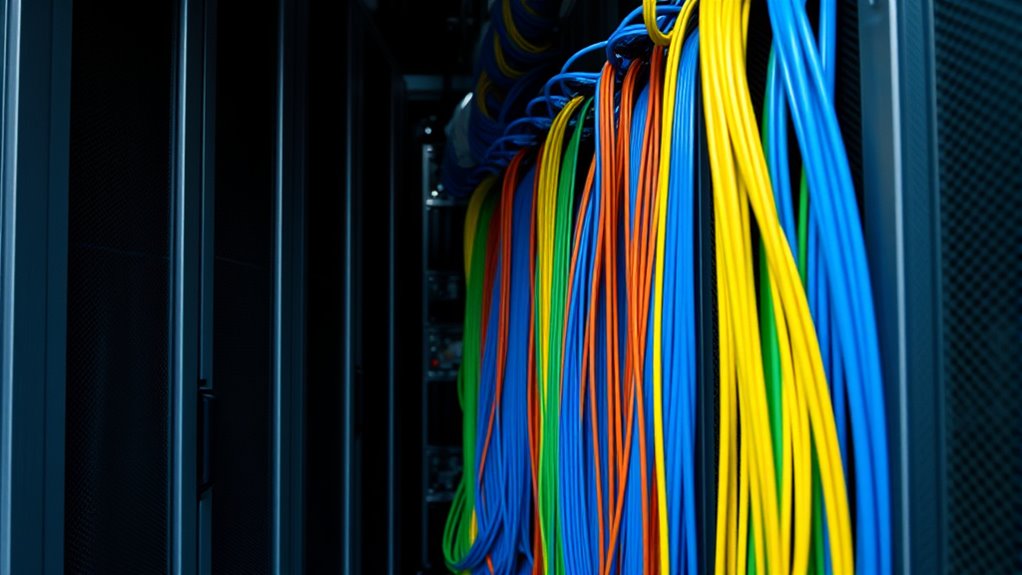
Implementing a universal color scheme helps you promote consistent wiring practices across your data center. It makes troubleshooting faster and more accurate by allowing technicians to identify cables at a glance. Adopting standardized colors ultimately improves your overall network reliability.
Promoting Consistent Wiring Practices
Adopting a universal color scheme for wiring in data centers is essential to guarantee consistency, improve safety, and streamline maintenance. When you standardize cable insulation and color dyeing, you reduce confusion and errors during installation and repairs. Consistent wiring practices help technicians quickly identify cables, minimizing downtime. To promote this, consider these key steps:
- Establish clear guidelines for cable insulation colors based on function
- Use uniform color dyeing techniques for easy identification
- Train staff regularly on standardized wiring protocols
Enhancing Troubleshooting Efficiency
When a universal cable color scheme is in place, troubleshooting becomes considerably faster and more accurate. You can quickly identify cables’ functions, reducing guesswork and minimizing downtime. Proper color coding training ensures your team understands the scheme, preventing errors during maintenance. Implementing clear cable management policies reinforces consistent practices, making it easier to trace connections and detect issues promptly. With standardized colors, you save time during inspections and repairs, leading to more efficient operations overall. By adhering to a universal scheme, you foster better communication among team members and improve overall network reliability. This proactive approach minimizes confusion, accelerates problem resolution, and enhances your data center’s operational efficiency. A consistent color strategy is a simple yet powerful tool to streamline troubleshooting processes.
Best Practices for Color Coding Documentation
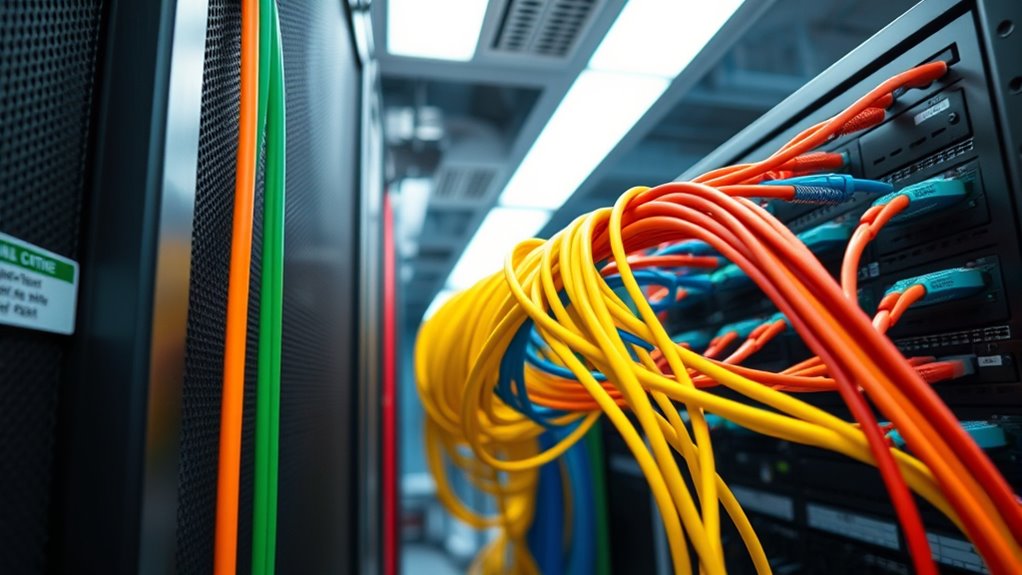
Establishing clear and consistent color coding practices for documentation is essential to guarantee quick identification and reduce errors. You should create standardized documentation color standards that everyone understands and follows. This ensures that color codes are meaningful and easy to interpret across teams. To reinforce this, invest in color coding training for staff, so everyone is familiar with the standards and best practices. Additionally, regularly update your documentation to reflect any changes in color schemes or equipment. Consistency is key—use the same colors for the same functions throughout all records. Keep detailed records of your color coding system, including explanations and updates, to facilitate onboarding and troubleshooting. Clear documentation minimizes confusion, speeds up maintenance, and enhances overall data center efficiency.
Safety Considerations in Cable Color Selection
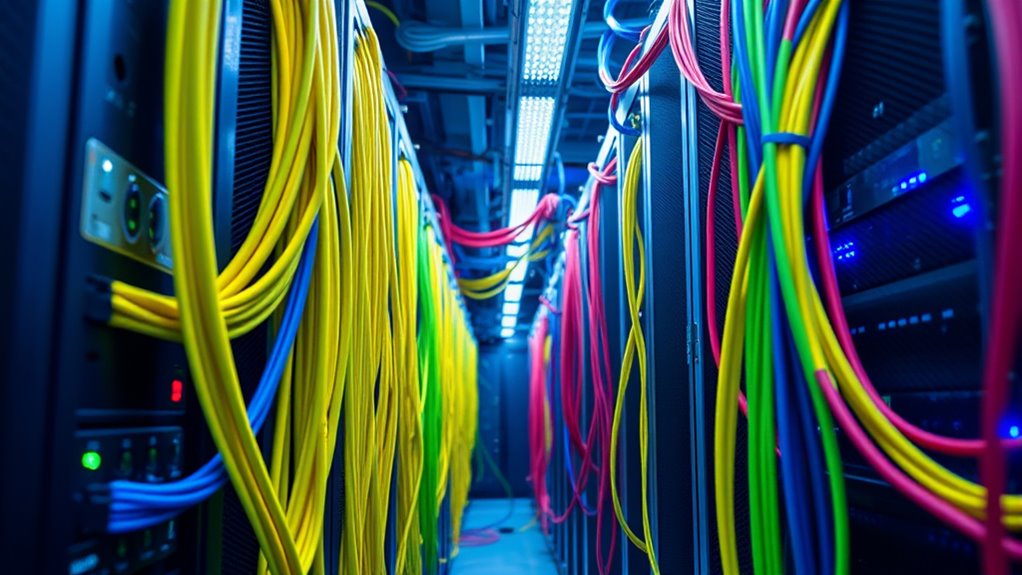
Choosing the right cable colors is crucial for safety, as it helps prevent accidents and guarantees quick response during emergencies. Proper color coding enhances grounding safety by clearly identifying grounding conductors, reducing the risk of electrical shocks or faults. Bright, standardized colors for grounding cables make them easily recognizable, ensuring maintenance crews handle them correctly. Additionally, consistent color schemes help prevent fire hazards by clearly distinguishing power cables from data or control cables, reducing accidental interference or overload. Using appropriate colors minimizes confusion during troubleshooting and emergency shutdowns. Always follow established standards to ensure everyone understands the cable functions instantly. Prioritizing safety in color selection not only protects personnel but also maintains the integrity and reliability of your data center’s electrical system.
Customizing Color Codes for Specific Equipment

Customizing color codes for specific equipment guarantees that your electrical system communicates clearly and reduces the risk of errors. By implementing custom color schemes and personalized cable labels, you tailor your system to meet unique operational needs. This approach helps technicians quickly identify circuits, reducing miswiring and downtime. To optimize your setup, consider:
Custom color codes and labels enhance clarity, safety, and efficiency in your electrical system.
- Developing a consistent color scheme for specialized equipment
- Using personalized cable labels with clear, equipment-specific information
- Adjusting standard standards to accommodate unique system requirements
These customizations make certain everyone understands cable functions at a glance, improving safety and efficiency. While standard colors provide a baseline, personalized adjustments make your data center more intuitive and error-resistant, supporting smooth operations and rapid troubleshooting.
Case Studies of Successful Color Coding Systems
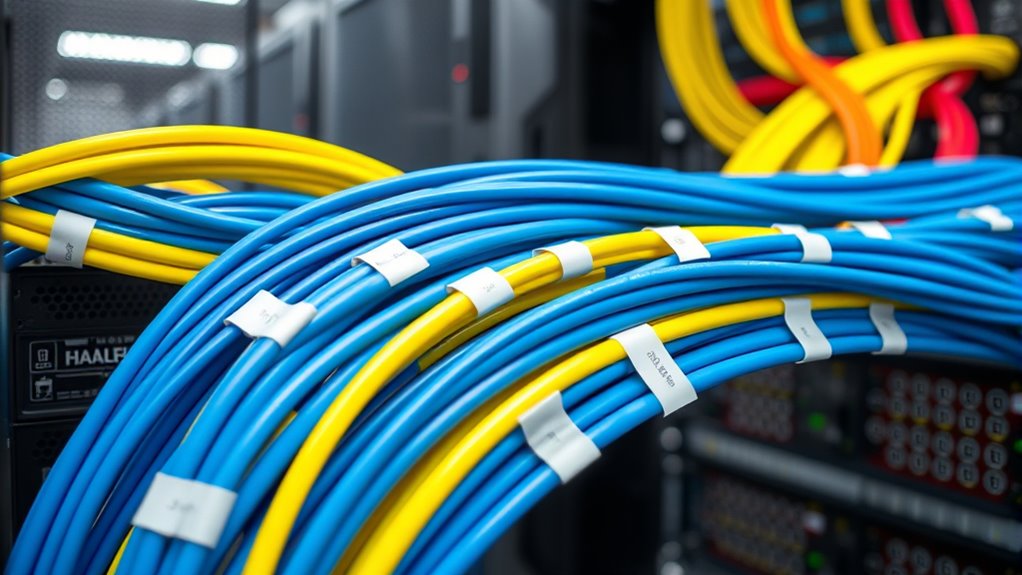
Implementing effective color coding systems can considerably boost operational efficiency and safety in data centers. A prime example is a facility that adopted innovative color schemes aligned with vendor-specific standards, simplifying maintenance and troubleshooting. By standardizing cable colors for power, data, and management lines, technicians quickly identify connections, reducing errors and downtime. Another success story involves a company that customized its color coding to match its unique infrastructure, streamlining cable management across multiple vendors. This approach minimized confusion during upgrades and repairs, saving time and reducing risks. These case studies demonstrate that adopting clear, consistent color schemes tailored to your environment enhances clarity and operational flow. Incorporating innovative color schemes based on vendor standards proves essential in creating scalable, efficient, and safe data center cable management systems.
Future Trends in Data Center Cable Management
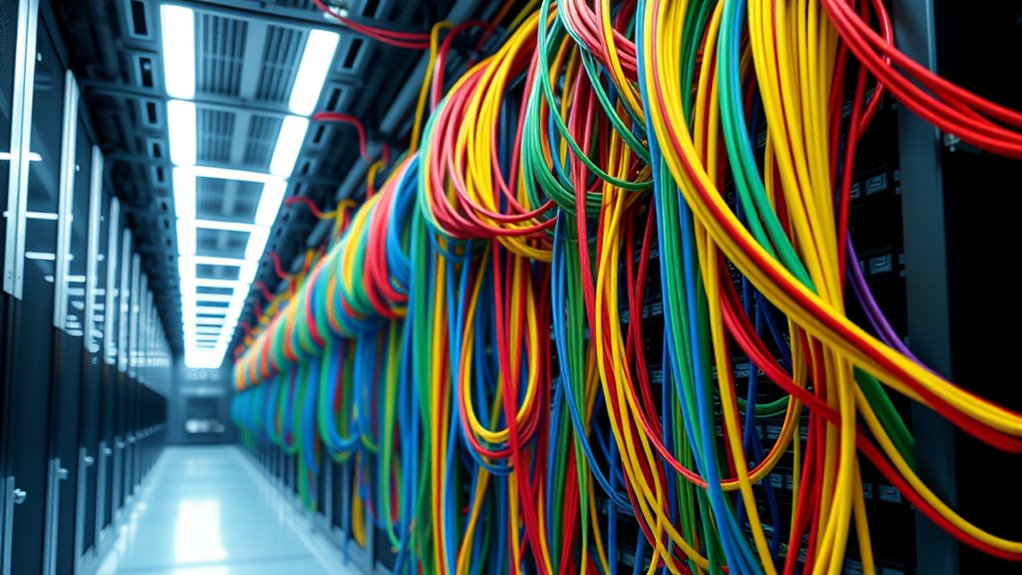
As data center technology advances, future trends in cable management are shifting toward greater automation and smarter systems. You’ll see increased use of wireless infrastructure, reducing physical cabling and enhancing flexibility. Integration with cooling systems will become more seamless, optimizing airflow and temperature control. Automated cable routing and monitoring tools will alert you to potential issues before they escalate.
- Wireless infrastructure minimizes clutter and simplifies upgrades
- Cooling system integration improves efficiency and reduces energy costs
- Smart cable management systems enable real-time adjustments and maintenance
These trends will make data centers more adaptable, efficient, and easier to manage, ensuring your infrastructure stays ahead of evolving demands. Embracing automation and integration will streamline operations, reduce downtime, and improve overall performance.
Frequently Asked Questions
How Do International Standards Influence Cable Color Coding in Data Centers?
International standards influence cable color coding in data centers by ensuring compliance across borders, making your setup universally understandable. When you follow these standards, you benefit from better standardization, reducing errors and streamlining maintenance. This global consistency helps you coordinate with international teams and suppliers, minimizing confusion. Overall, adhering to international compliance and standardization benefits your data center’s efficiency, safety, and interoperability, making your infrastructure more reliable and easier to manage.
What Are the Cost Implications of Implementing Universal Color Schemes?
Implementing universal color schemes can increase initial training costs, as your team needs time to learn new standards. However, it can lower maintenance expenses over time by reducing errors and streamlining troubleshooting. While there’s an upfront investment, the long-term savings from easier identification and fewer mistakes outweigh the costs. Overall, adopting universal color codes can be cost-effective, especially when considering improved efficiency and reduced downtime.
How Often Should Cable Color Coding Documentation Be Reviewed and Updated?
You should review and update your cable management and color coding best practices at least annually. Regular reviews ensure your documentation stays accurate as your data center evolves, helping prevent confusion and errors. Changes in equipment or network configurations may require updates to color coding standards. Staying current with your documentation promotes efficient troubleshooting and maintains a consistent, organized environment, ultimately supporting excellent data center operations.
Are There Industry-Specific Color Coding Variations for Data Center Cables?
Yes, industry-specific protocols and regional variations influence cable color coding in data centers. You should check local standards and guidelines tailored to your sector, as they may have unique color schemes for different functions. These variations help guarantee clarity and safety across regions. Stay informed about regional standards and adapt your cable color coding accordingly to maintain compliance and facilitate efficient troubleshooting and management within your data center.
How Can Color Coding Assist in Disaster Recovery and Troubleshooting?
Color coding can greatly simplify disaster recovery and troubleshooting by streamlining cable management and enabling fault isolation. By using distinct colors, you can quickly identify and trace specific cables, reducing downtime and confusion. This visual clarity helps you isolate faults faster, prevent cascading issues, and restore service swiftly. Effective color coding ensures your data center stays organized, efficient, and resilient, making your troubleshooting tasks more straightforward and less stressful.
Conclusion
By embracing consistent cable color standards, you weave a vibrant tapestry of organization amid the data center’s chaos. Think of colors as your guiding stars, illuminating pathways and preventing tangled webs. With clear guidelines, safety becomes your shield, and efficiency your melody. As technology evolves, let your color scheme dance in harmony, transforming clutter into clarity. In this symphony of cables, your thoughtful choices compose a masterpiece of seamless, resilient data management.



